Business Model Canvas Analysis and Design
VerifiedAdded on 2021/04/16
|10
|2097
|81
AI Summary
This assignment requires analyzing a business model using the Business Model Canvas (BMC) template. The BMC is a strategic management tool used to visualize, challenge, and improve business models. It consists of nine building blocks: customers, value proposition, channels, revenue streams, key resources, key activities, key partnerships, cost structure, and customer relationships. The assignment asks to complete the BMC for a beauty subscription box service company, including identifying key partners, activities, resources, costs, revenue streams, and customer segments. It also requires understanding the business model canvas template, its components, and how to design a business model using this framework.
Contribute Materials
Your contribution can guide someone’s learning journey. Share your
documents today.

Running head: IDEA GENERATION
IDEA GENERATION
Name of the Student:
Name of the University:
Authors Note:
IDEA GENERATION
Name of the Student:
Name of the University:
Authors Note:
Secure Best Marks with AI Grader
Need help grading? Try our AI Grader for instant feedback on your assignments.
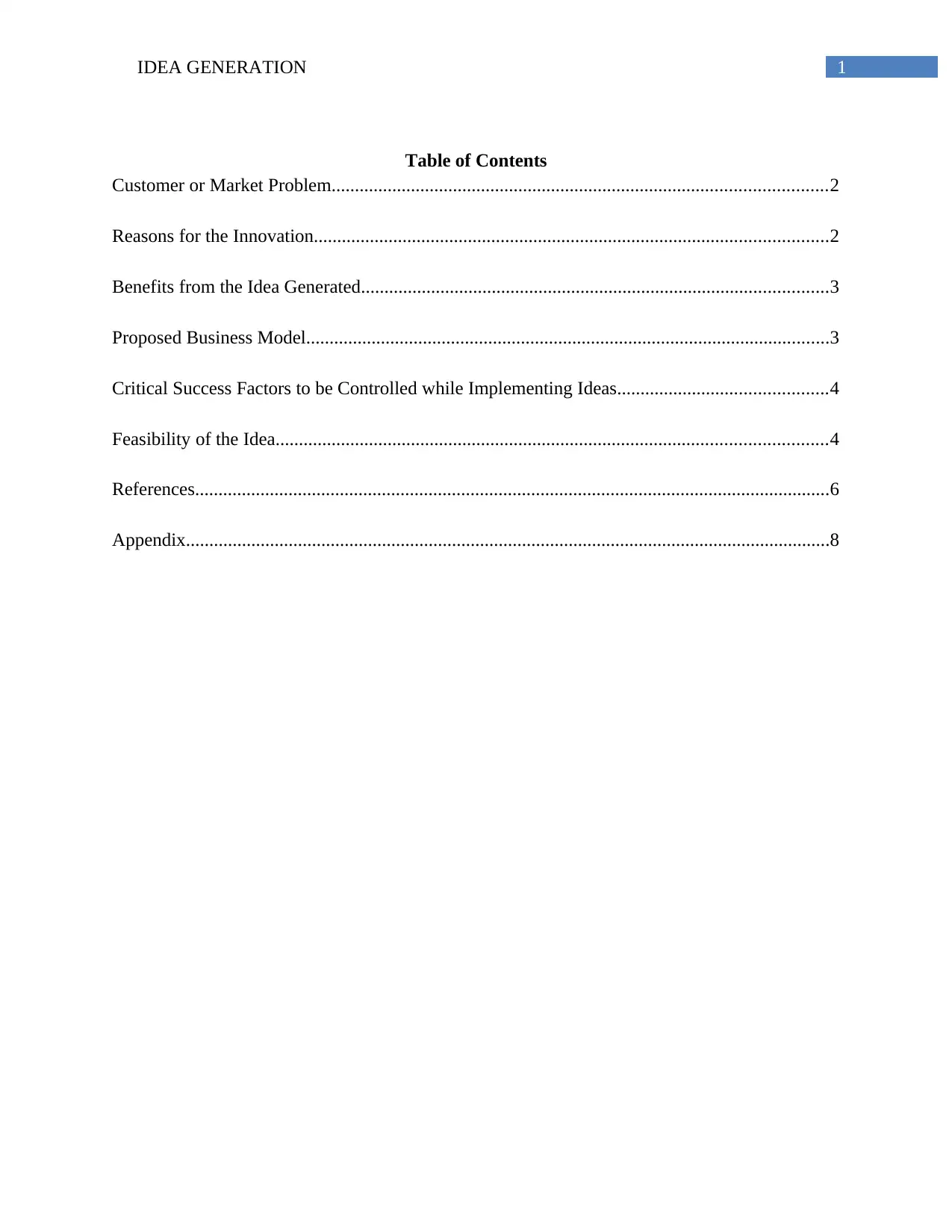
1IDEA GENERATION
Table of Contents
Customer or Market Problem..........................................................................................................2
Reasons for the Innovation..............................................................................................................2
Benefits from the Idea Generated....................................................................................................3
Proposed Business Model................................................................................................................3
Critical Success Factors to be Controlled while Implementing Ideas.............................................4
Feasibility of the Idea......................................................................................................................4
References........................................................................................................................................6
Appendix..........................................................................................................................................8
Table of Contents
Customer or Market Problem..........................................................................................................2
Reasons for the Innovation..............................................................................................................2
Benefits from the Idea Generated....................................................................................................3
Proposed Business Model................................................................................................................3
Critical Success Factors to be Controlled while Implementing Ideas.............................................4
Feasibility of the Idea......................................................................................................................4
References........................................................................................................................................6
Appendix..........................................................................................................................................8
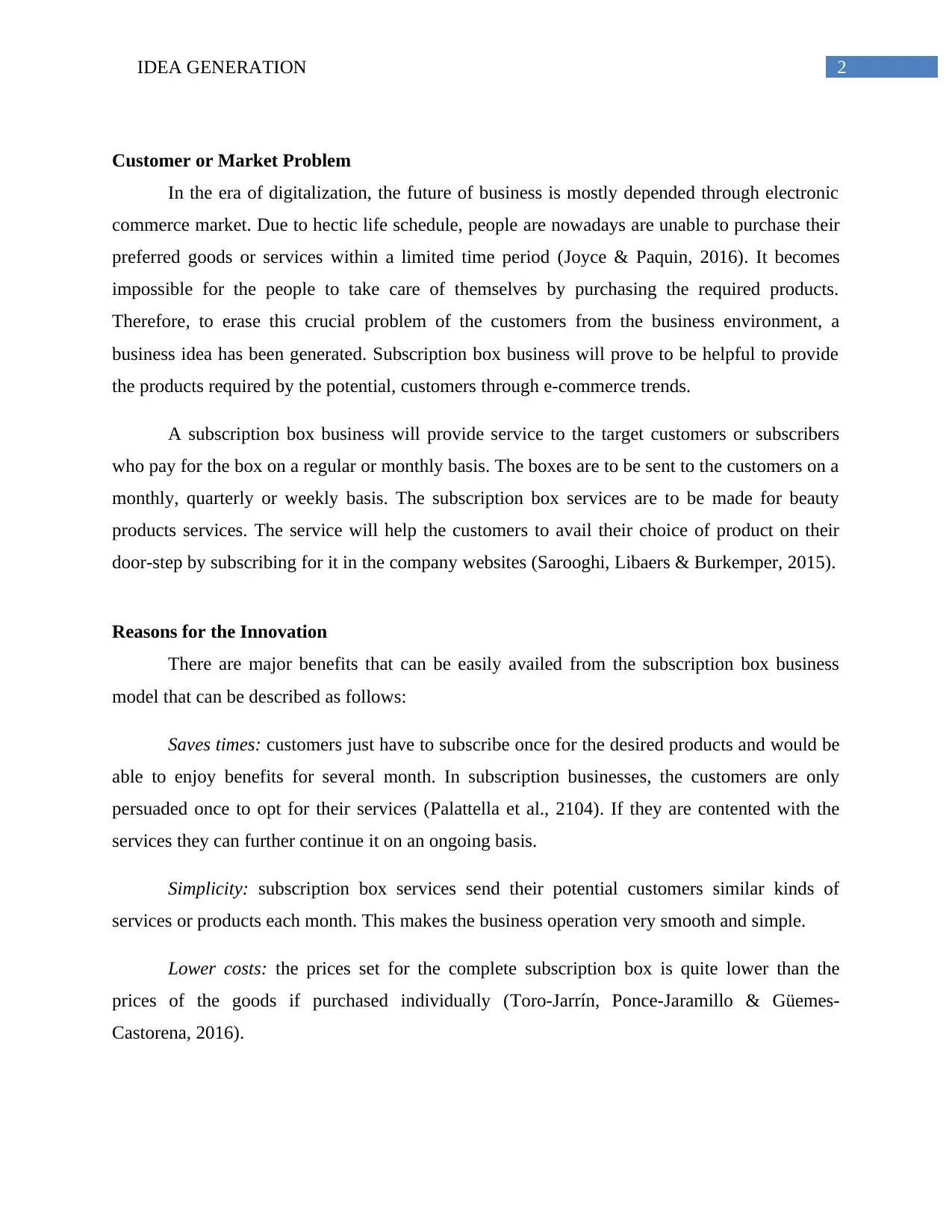
2IDEA GENERATION
Customer or Market Problem
In the era of digitalization, the future of business is mostly depended through electronic
commerce market. Due to hectic life schedule, people are nowadays are unable to purchase their
preferred goods or services within a limited time period (Joyce & Paquin, 2016). It becomes
impossible for the people to take care of themselves by purchasing the required products.
Therefore, to erase this crucial problem of the customers from the business environment, a
business idea has been generated. Subscription box business will prove to be helpful to provide
the products required by the potential, customers through e-commerce trends.
A subscription box business will provide service to the target customers or subscribers
who pay for the box on a regular or monthly basis. The boxes are to be sent to the customers on a
monthly, quarterly or weekly basis. The subscription box services are to be made for beauty
products services. The service will help the customers to avail their choice of product on their
door-step by subscribing for it in the company websites (Sarooghi, Libaers & Burkemper, 2015).
Reasons for the Innovation
There are major benefits that can be easily availed from the subscription box business
model that can be described as follows:
Saves times: customers just have to subscribe once for the desired products and would be
able to enjoy benefits for several month. In subscription businesses, the customers are only
persuaded once to opt for their services (Palattella et al., 2104). If they are contented with the
services they can further continue it on an ongoing basis.
Simplicity: subscription box services send their potential customers similar kinds of
services or products each month. This makes the business operation very smooth and simple.
Lower costs: the prices set for the complete subscription box is quite lower than the
prices of the goods if purchased individually (Toro-Jarrín, Ponce-Jaramillo & Güemes-
Castorena, 2016).
Customer or Market Problem
In the era of digitalization, the future of business is mostly depended through electronic
commerce market. Due to hectic life schedule, people are nowadays are unable to purchase their
preferred goods or services within a limited time period (Joyce & Paquin, 2016). It becomes
impossible for the people to take care of themselves by purchasing the required products.
Therefore, to erase this crucial problem of the customers from the business environment, a
business idea has been generated. Subscription box business will prove to be helpful to provide
the products required by the potential, customers through e-commerce trends.
A subscription box business will provide service to the target customers or subscribers
who pay for the box on a regular or monthly basis. The boxes are to be sent to the customers on a
monthly, quarterly or weekly basis. The subscription box services are to be made for beauty
products services. The service will help the customers to avail their choice of product on their
door-step by subscribing for it in the company websites (Sarooghi, Libaers & Burkemper, 2015).
Reasons for the Innovation
There are major benefits that can be easily availed from the subscription box business
model that can be described as follows:
Saves times: customers just have to subscribe once for the desired products and would be
able to enjoy benefits for several month. In subscription businesses, the customers are only
persuaded once to opt for their services (Palattella et al., 2104). If they are contented with the
services they can further continue it on an ongoing basis.
Simplicity: subscription box services send their potential customers similar kinds of
services or products each month. This makes the business operation very smooth and simple.
Lower costs: the prices set for the complete subscription box is quite lower than the
prices of the goods if purchased individually (Toro-Jarrín, Ponce-Jaramillo & Güemes-
Castorena, 2016).
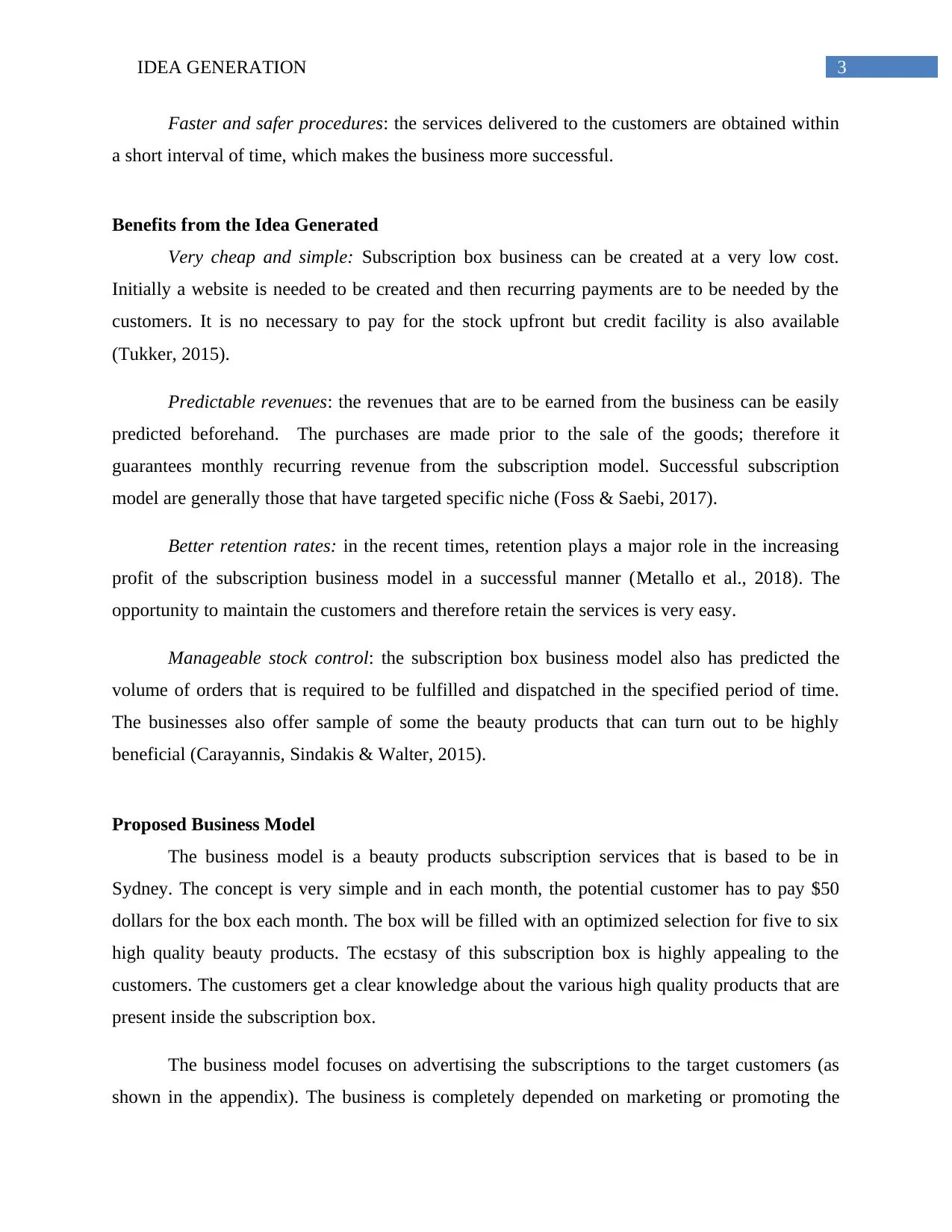
3IDEA GENERATION
Faster and safer procedures: the services delivered to the customers are obtained within
a short interval of time, which makes the business more successful.
Benefits from the Idea Generated
Very cheap and simple: Subscription box business can be created at a very low cost.
Initially a website is needed to be created and then recurring payments are to be needed by the
customers. It is no necessary to pay for the stock upfront but credit facility is also available
(Tukker, 2015).
Predictable revenues: the revenues that are to be earned from the business can be easily
predicted beforehand. The purchases are made prior to the sale of the goods; therefore it
guarantees monthly recurring revenue from the subscription model. Successful subscription
model are generally those that have targeted specific niche (Foss & Saebi, 2017).
Better retention rates: in the recent times, retention plays a major role in the increasing
profit of the subscription business model in a successful manner (Metallo et al., 2018). The
opportunity to maintain the customers and therefore retain the services is very easy.
Manageable stock control: the subscription box business model also has predicted the
volume of orders that is required to be fulfilled and dispatched in the specified period of time.
The businesses also offer sample of some the beauty products that can turn out to be highly
beneficial (Carayannis, Sindakis & Walter, 2015).
Proposed Business Model
The business model is a beauty products subscription services that is based to be in
Sydney. The concept is very simple and in each month, the potential customer has to pay $50
dollars for the box each month. The box will be filled with an optimized selection for five to six
high quality beauty products. The ecstasy of this subscription box is highly appealing to the
customers. The customers get a clear knowledge about the various high quality products that are
present inside the subscription box.
The business model focuses on advertising the subscriptions to the target customers (as
shown in the appendix). The business is completely depended on marketing or promoting the
Faster and safer procedures: the services delivered to the customers are obtained within
a short interval of time, which makes the business more successful.
Benefits from the Idea Generated
Very cheap and simple: Subscription box business can be created at a very low cost.
Initially a website is needed to be created and then recurring payments are to be needed by the
customers. It is no necessary to pay for the stock upfront but credit facility is also available
(Tukker, 2015).
Predictable revenues: the revenues that are to be earned from the business can be easily
predicted beforehand. The purchases are made prior to the sale of the goods; therefore it
guarantees monthly recurring revenue from the subscription model. Successful subscription
model are generally those that have targeted specific niche (Foss & Saebi, 2017).
Better retention rates: in the recent times, retention plays a major role in the increasing
profit of the subscription business model in a successful manner (Metallo et al., 2018). The
opportunity to maintain the customers and therefore retain the services is very easy.
Manageable stock control: the subscription box business model also has predicted the
volume of orders that is required to be fulfilled and dispatched in the specified period of time.
The businesses also offer sample of some the beauty products that can turn out to be highly
beneficial (Carayannis, Sindakis & Walter, 2015).
Proposed Business Model
The business model is a beauty products subscription services that is based to be in
Sydney. The concept is very simple and in each month, the potential customer has to pay $50
dollars for the box each month. The box will be filled with an optimized selection for five to six
high quality beauty products. The ecstasy of this subscription box is highly appealing to the
customers. The customers get a clear knowledge about the various high quality products that are
present inside the subscription box.
The business model focuses on advertising the subscriptions to the target customers (as
shown in the appendix). The business is completely depended on marketing or promoting the
Secure Best Marks with AI Grader
Need help grading? Try our AI Grader for instant feedback on your assignments.
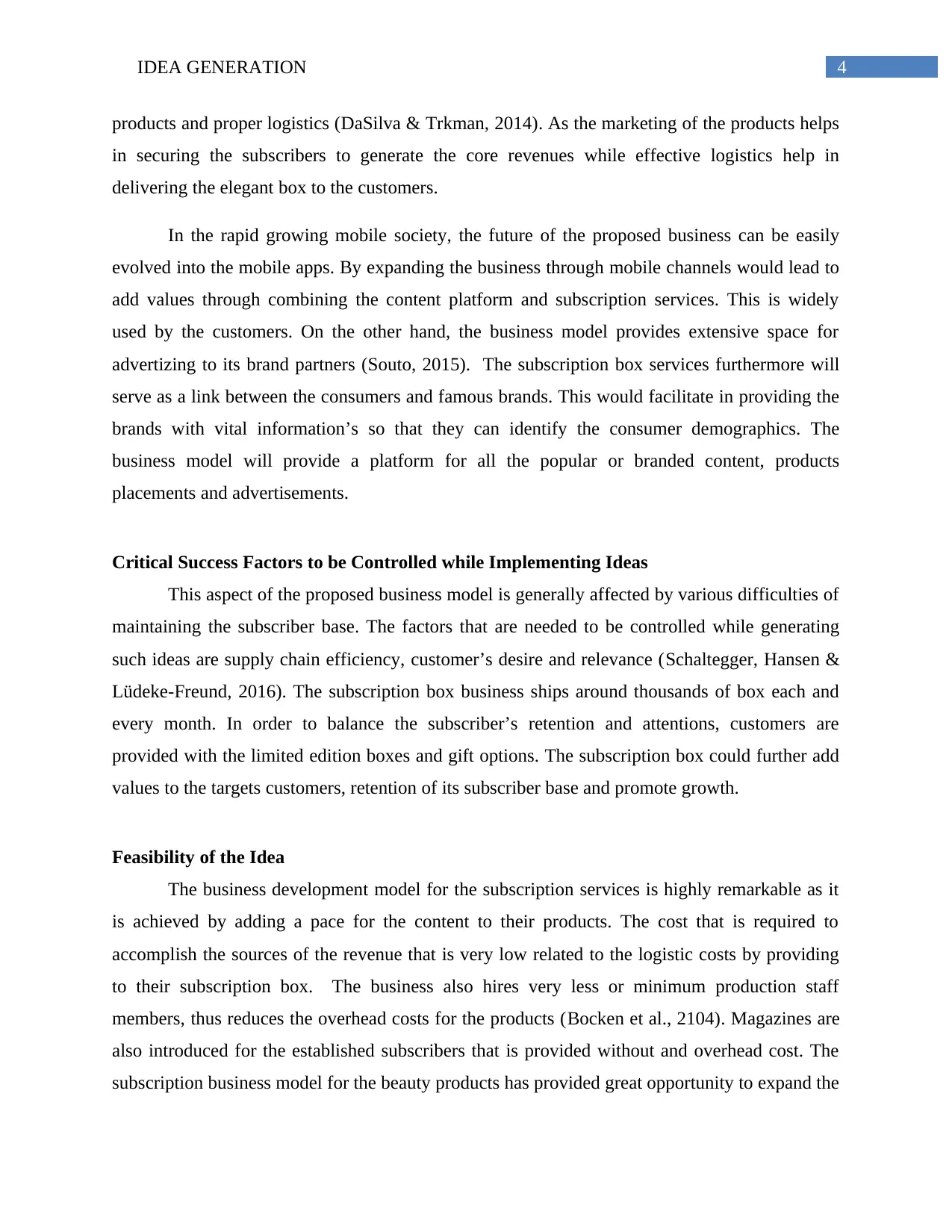
4IDEA GENERATION
products and proper logistics (DaSilva & Trkman, 2014). As the marketing of the products helps
in securing the subscribers to generate the core revenues while effective logistics help in
delivering the elegant box to the customers.
In the rapid growing mobile society, the future of the proposed business can be easily
evolved into the mobile apps. By expanding the business through mobile channels would lead to
add values through combining the content platform and subscription services. This is widely
used by the customers. On the other hand, the business model provides extensive space for
advertizing to its brand partners (Souto, 2015). The subscription box services furthermore will
serve as a link between the consumers and famous brands. This would facilitate in providing the
brands with vital information’s so that they can identify the consumer demographics. The
business model will provide a platform for all the popular or branded content, products
placements and advertisements.
Critical Success Factors to be Controlled while Implementing Ideas
This aspect of the proposed business model is generally affected by various difficulties of
maintaining the subscriber base. The factors that are needed to be controlled while generating
such ideas are supply chain efficiency, customer’s desire and relevance (Schaltegger, Hansen &
Lüdeke-Freund, 2016). The subscription box business ships around thousands of box each and
every month. In order to balance the subscriber’s retention and attentions, customers are
provided with the limited edition boxes and gift options. The subscription box could further add
values to the targets customers, retention of its subscriber base and promote growth.
Feasibility of the Idea
The business development model for the subscription services is highly remarkable as it
is achieved by adding a pace for the content to their products. The cost that is required to
accomplish the sources of the revenue that is very low related to the logistic costs by providing
to their subscription box. The business also hires very less or minimum production staff
members, thus reduces the overhead costs for the products (Bocken et al., 2104). Magazines are
also introduced for the established subscribers that is provided without and overhead cost. The
subscription business model for the beauty products has provided great opportunity to expand the
products and proper logistics (DaSilva & Trkman, 2014). As the marketing of the products helps
in securing the subscribers to generate the core revenues while effective logistics help in
delivering the elegant box to the customers.
In the rapid growing mobile society, the future of the proposed business can be easily
evolved into the mobile apps. By expanding the business through mobile channels would lead to
add values through combining the content platform and subscription services. This is widely
used by the customers. On the other hand, the business model provides extensive space for
advertizing to its brand partners (Souto, 2015). The subscription box services furthermore will
serve as a link between the consumers and famous brands. This would facilitate in providing the
brands with vital information’s so that they can identify the consumer demographics. The
business model will provide a platform for all the popular or branded content, products
placements and advertisements.
Critical Success Factors to be Controlled while Implementing Ideas
This aspect of the proposed business model is generally affected by various difficulties of
maintaining the subscriber base. The factors that are needed to be controlled while generating
such ideas are supply chain efficiency, customer’s desire and relevance (Schaltegger, Hansen &
Lüdeke-Freund, 2016). The subscription box business ships around thousands of box each and
every month. In order to balance the subscriber’s retention and attentions, customers are
provided with the limited edition boxes and gift options. The subscription box could further add
values to the targets customers, retention of its subscriber base and promote growth.
Feasibility of the Idea
The business development model for the subscription services is highly remarkable as it
is achieved by adding a pace for the content to their products. The cost that is required to
accomplish the sources of the revenue that is very low related to the logistic costs by providing
to their subscription box. The business also hires very less or minimum production staff
members, thus reduces the overhead costs for the products (Bocken et al., 2104). Magazines are
also introduced for the established subscribers that is provided without and overhead cost. The
subscription business model for the beauty products has provided great opportunity to expand the
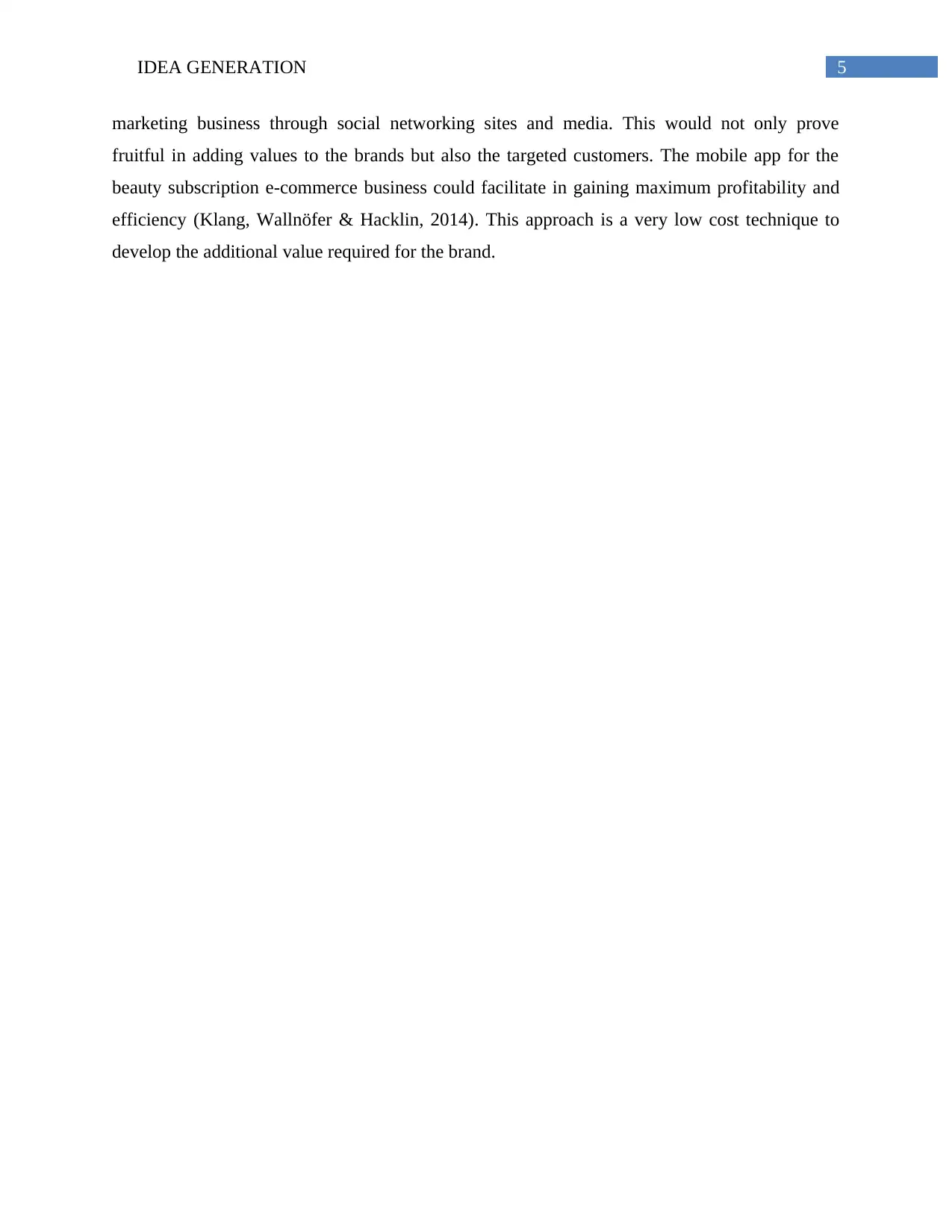
5IDEA GENERATION
marketing business through social networking sites and media. This would not only prove
fruitful in adding values to the brands but also the targeted customers. The mobile app for the
beauty subscription e-commerce business could facilitate in gaining maximum profitability and
efficiency (Klang, Wallnöfer & Hacklin, 2014). This approach is a very low cost technique to
develop the additional value required for the brand.
marketing business through social networking sites and media. This would not only prove
fruitful in adding values to the brands but also the targeted customers. The mobile app for the
beauty subscription e-commerce business could facilitate in gaining maximum profitability and
efficiency (Klang, Wallnöfer & Hacklin, 2014). This approach is a very low cost technique to
develop the additional value required for the brand.
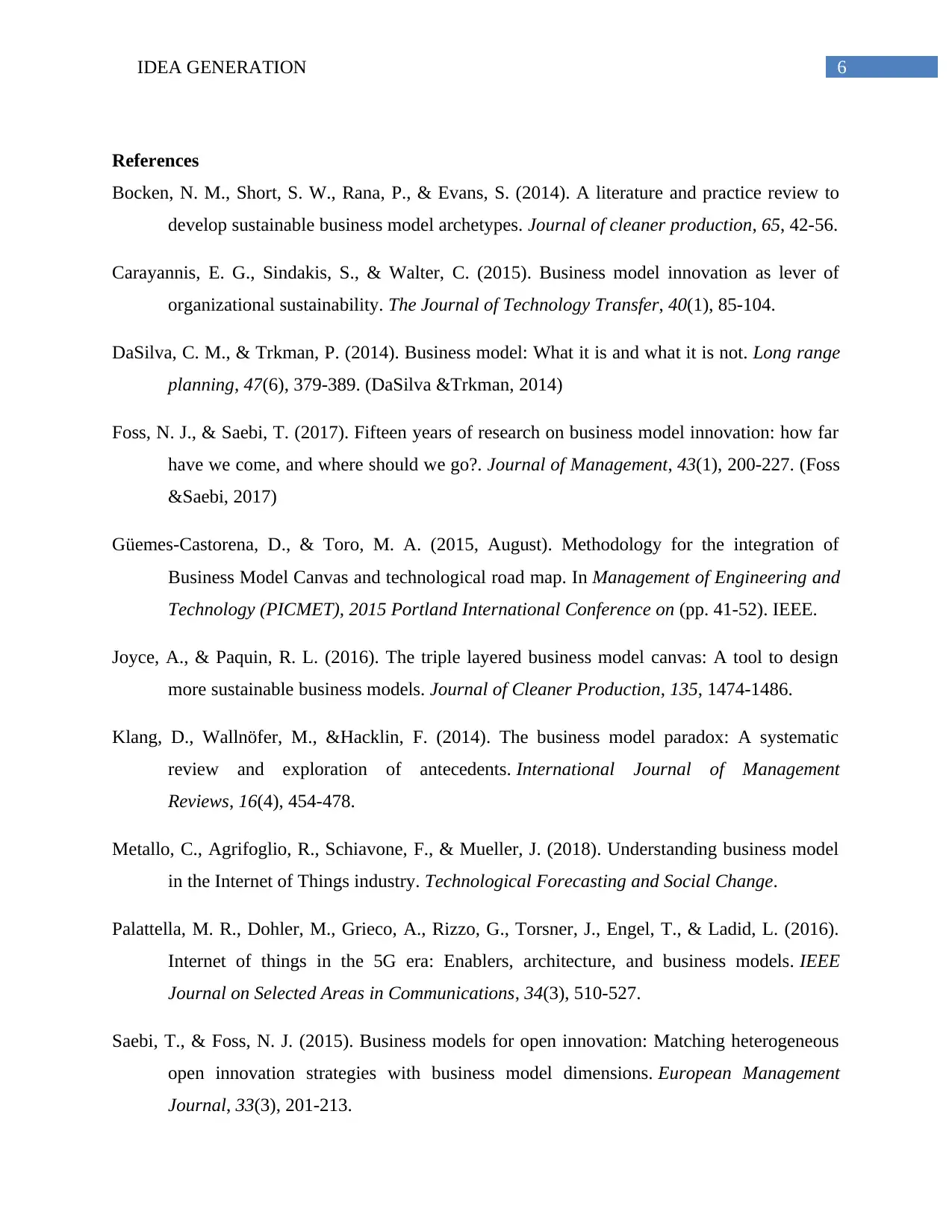
6IDEA GENERATION
References
Bocken, N. M., Short, S. W., Rana, P., & Evans, S. (2014). A literature and practice review to
develop sustainable business model archetypes. Journal of cleaner production, 65, 42-56.
Carayannis, E. G., Sindakis, S., & Walter, C. (2015). Business model innovation as lever of
organizational sustainability. The Journal of Technology Transfer, 40(1), 85-104.
DaSilva, C. M., & Trkman, P. (2014). Business model: What it is and what it is not. Long range
planning, 47(6), 379-389. (DaSilva &Trkman, 2014)
Foss, N. J., & Saebi, T. (2017). Fifteen years of research on business model innovation: how far
have we come, and where should we go?. Journal of Management, 43(1), 200-227. (Foss
&Saebi, 2017)
Güemes-Castorena, D., & Toro, M. A. (2015, August). Methodology for the integration of
Business Model Canvas and technological road map. In Management of Engineering and
Technology (PICMET), 2015 Portland International Conference on (pp. 41-52). IEEE.
Joyce, A., & Paquin, R. L. (2016). The triple layered business model canvas: A tool to design
more sustainable business models. Journal of Cleaner Production, 135, 1474-1486.
Klang, D., Wallnöfer, M., &Hacklin, F. (2014). The business model paradox: A systematic
review and exploration of antecedents. International Journal of Management
Reviews, 16(4), 454-478.
Metallo, C., Agrifoglio, R., Schiavone, F., & Mueller, J. (2018). Understanding business model
in the Internet of Things industry. Technological Forecasting and Social Change.
Palattella, M. R., Dohler, M., Grieco, A., Rizzo, G., Torsner, J., Engel, T., & Ladid, L. (2016).
Internet of things in the 5G era: Enablers, architecture, and business models. IEEE
Journal on Selected Areas in Communications, 34(3), 510-527.
Saebi, T., & Foss, N. J. (2015). Business models for open innovation: Matching heterogeneous
open innovation strategies with business model dimensions. European Management
Journal, 33(3), 201-213.
References
Bocken, N. M., Short, S. W., Rana, P., & Evans, S. (2014). A literature and practice review to
develop sustainable business model archetypes. Journal of cleaner production, 65, 42-56.
Carayannis, E. G., Sindakis, S., & Walter, C. (2015). Business model innovation as lever of
organizational sustainability. The Journal of Technology Transfer, 40(1), 85-104.
DaSilva, C. M., & Trkman, P. (2014). Business model: What it is and what it is not. Long range
planning, 47(6), 379-389. (DaSilva &Trkman, 2014)
Foss, N. J., & Saebi, T. (2017). Fifteen years of research on business model innovation: how far
have we come, and where should we go?. Journal of Management, 43(1), 200-227. (Foss
&Saebi, 2017)
Güemes-Castorena, D., & Toro, M. A. (2015, August). Methodology for the integration of
Business Model Canvas and technological road map. In Management of Engineering and
Technology (PICMET), 2015 Portland International Conference on (pp. 41-52). IEEE.
Joyce, A., & Paquin, R. L. (2016). The triple layered business model canvas: A tool to design
more sustainable business models. Journal of Cleaner Production, 135, 1474-1486.
Klang, D., Wallnöfer, M., &Hacklin, F. (2014). The business model paradox: A systematic
review and exploration of antecedents. International Journal of Management
Reviews, 16(4), 454-478.
Metallo, C., Agrifoglio, R., Schiavone, F., & Mueller, J. (2018). Understanding business model
in the Internet of Things industry. Technological Forecasting and Social Change.
Palattella, M. R., Dohler, M., Grieco, A., Rizzo, G., Torsner, J., Engel, T., & Ladid, L. (2016).
Internet of things in the 5G era: Enablers, architecture, and business models. IEEE
Journal on Selected Areas in Communications, 34(3), 510-527.
Saebi, T., & Foss, N. J. (2015). Business models for open innovation: Matching heterogeneous
open innovation strategies with business model dimensions. European Management
Journal, 33(3), 201-213.
Paraphrase This Document
Need a fresh take? Get an instant paraphrase of this document with our AI Paraphraser
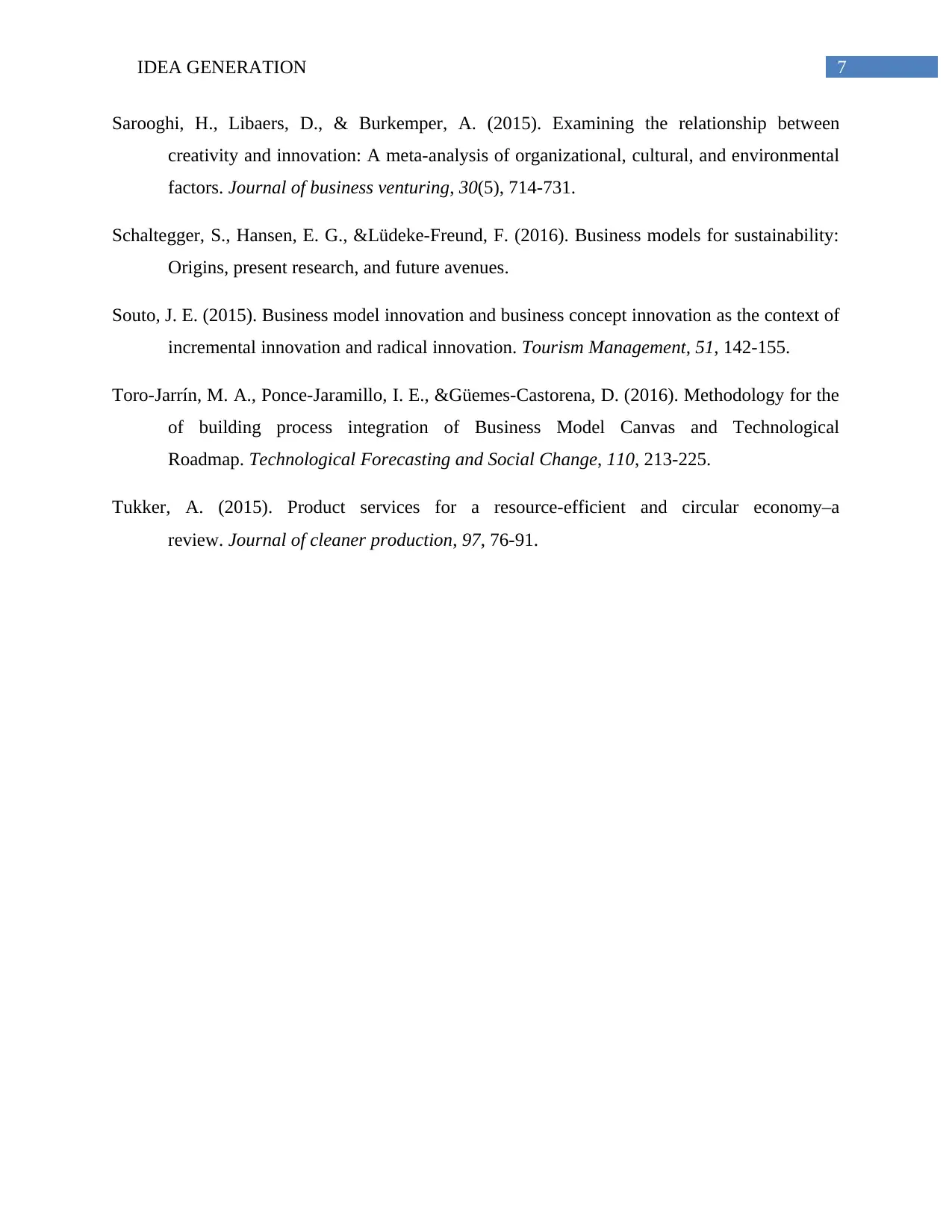
7IDEA GENERATION
Sarooghi, H., Libaers, D., & Burkemper, A. (2015). Examining the relationship between
creativity and innovation: A meta-analysis of organizational, cultural, and environmental
factors. Journal of business venturing, 30(5), 714-731.
Schaltegger, S., Hansen, E. G., &Lüdeke-Freund, F. (2016). Business models for sustainability:
Origins, present research, and future avenues.
Souto, J. E. (2015). Business model innovation and business concept innovation as the context of
incremental innovation and radical innovation. Tourism Management, 51, 142-155.
Toro-Jarrín, M. A., Ponce-Jaramillo, I. E., &Güemes-Castorena, D. (2016). Methodology for the
of building process integration of Business Model Canvas and Technological
Roadmap. Technological Forecasting and Social Change, 110, 213-225.
Tukker, A. (2015). Product services for a resource-efficient and circular economy–a
review. Journal of cleaner production, 97, 76-91.
Sarooghi, H., Libaers, D., & Burkemper, A. (2015). Examining the relationship between
creativity and innovation: A meta-analysis of organizational, cultural, and environmental
factors. Journal of business venturing, 30(5), 714-731.
Schaltegger, S., Hansen, E. G., &Lüdeke-Freund, F. (2016). Business models for sustainability:
Origins, present research, and future avenues.
Souto, J. E. (2015). Business model innovation and business concept innovation as the context of
incremental innovation and radical innovation. Tourism Management, 51, 142-155.
Toro-Jarrín, M. A., Ponce-Jaramillo, I. E., &Güemes-Castorena, D. (2016). Methodology for the
of building process integration of Business Model Canvas and Technological
Roadmap. Technological Forecasting and Social Change, 110, 213-225.
Tukker, A. (2015). Product services for a resource-efficient and circular economy–a
review. Journal of cleaner production, 97, 76-91.
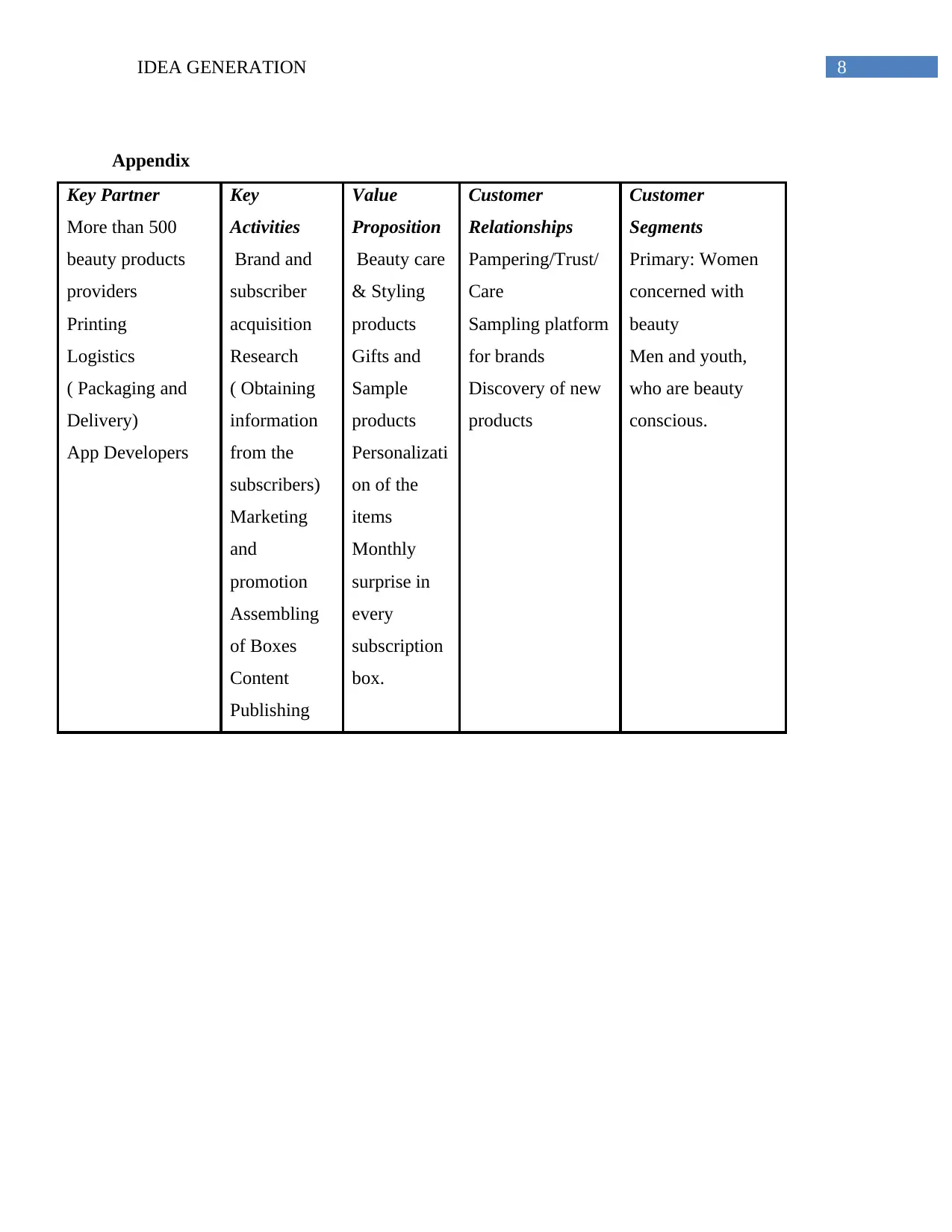
8IDEA GENERATION
Appendix
Key Partner
More than 500
beauty products
providers
Printing
Logistics
( Packaging and
Delivery)
App Developers
Key
Activities
Brand and
subscriber
acquisition
Research
( Obtaining
information
from the
subscribers)
Marketing
and
promotion
Assembling
of Boxes
Content
Publishing
Value
Proposition
Beauty care
& Styling
products
Gifts and
Sample
products
Personalizati
on of the
items
Monthly
surprise in
every
subscription
box.
Customer
Relationships
Pampering/Trust/
Care
Sampling platform
for brands
Discovery of new
products
Customer
Segments
Primary: Women
concerned with
beauty
Men and youth,
who are beauty
conscious.
Appendix
Key Partner
More than 500
beauty products
providers
Printing
Logistics
( Packaging and
Delivery)
App Developers
Key
Activities
Brand and
subscriber
acquisition
Research
( Obtaining
information
from the
subscribers)
Marketing
and
promotion
Assembling
of Boxes
Content
Publishing
Value
Proposition
Beauty care
& Styling
products
Gifts and
Sample
products
Personalizati
on of the
items
Monthly
surprise in
every
subscription
box.
Customer
Relationships
Pampering/Trust/
Care
Sampling platform
for brands
Discovery of new
products
Customer
Segments
Primary: Women
concerned with
beauty
Men and youth,
who are beauty
conscious.
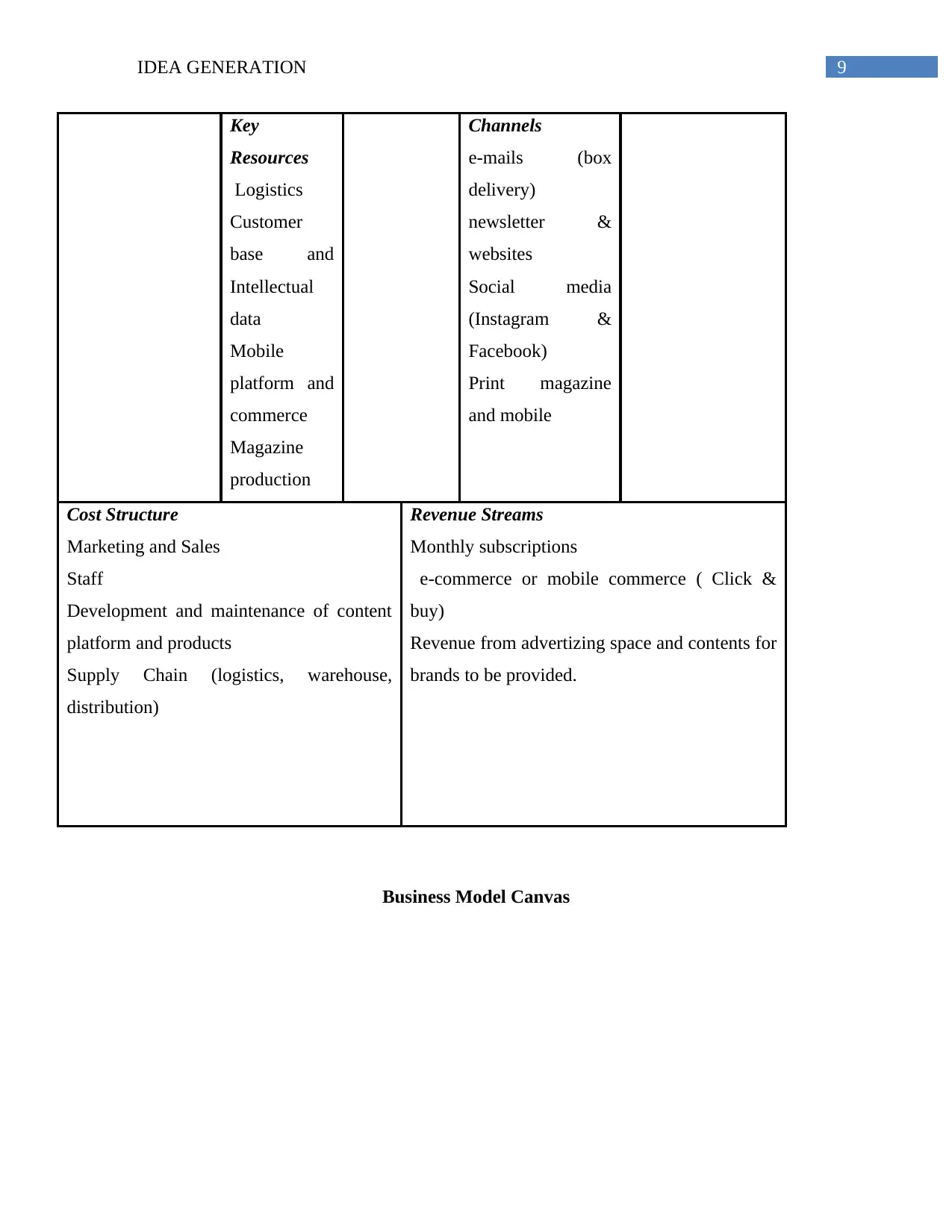
9IDEA GENERATION
Key
Resources
Logistics
Customer
base and
Intellectual
data
Mobile
platform and
commerce
Magazine
production
Channels
e-mails (box
delivery)
newsletter &
websites
Social media
(Instagram &
Facebook)
Print magazine
and mobile
Cost Structure
Marketing and Sales
Staff
Development and maintenance of content
platform and products
Supply Chain (logistics, warehouse,
distribution)
Revenue Streams
Monthly subscriptions
e-commerce or mobile commerce ( Click &
buy)
Revenue from advertizing space and contents for
brands to be provided.
Business Model Canvas
Key
Resources
Logistics
Customer
base and
Intellectual
data
Mobile
platform and
commerce
Magazine
production
Channels
e-mails (box
delivery)
newsletter &
websites
Social media
(Instagram &
Facebook)
Print magazine
and mobile
Cost Structure
Marketing and Sales
Staff
Development and maintenance of content
platform and products
Supply Chain (logistics, warehouse,
distribution)
Revenue Streams
Monthly subscriptions
e-commerce or mobile commerce ( Click &
buy)
Revenue from advertizing space and contents for
brands to be provided.
Business Model Canvas
1 out of 10
Related Documents
Your All-in-One AI-Powered Toolkit for Academic Success.
+13062052269
info@desklib.com
Available 24*7 on WhatsApp / Email
![[object Object]](/_next/static/media/star-bottom.7253800d.svg)
Unlock your academic potential
© 2024 | Zucol Services PVT LTD | All rights reserved.





